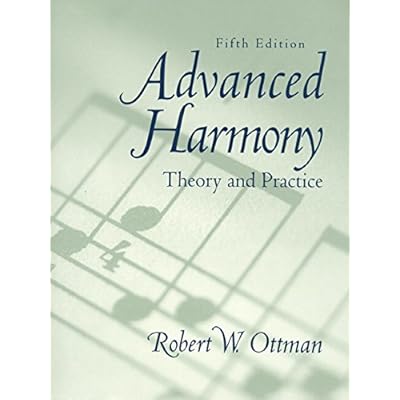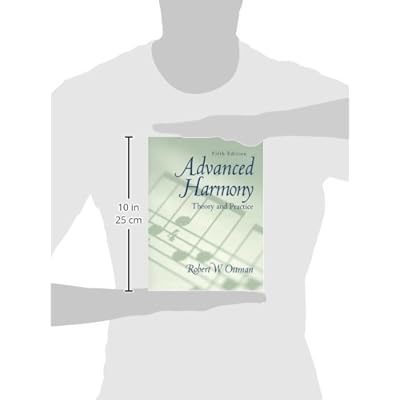Advanced Harmony: Theory and Practice with CD Package (5th Edition)
Category: Books,Arts & Photography,Music
Advanced Harmony: Theory and Practice with CD Package (5th Edition) Details
From the Inside Flap Preface Advanced Harmony: Theory and Practice, fifth edition, continues the course of instruction in basic music theory begun in Elementary Harmony: Theory and Practice, fifth edition (Prentice Hall, 1998). These two volumes include materials ranging from music fundamentals through twentieth-century music. The contents cover the needs of the usual two-year college music theory program in the subjects of harmony, melody, and form, with applications to analysis, writing (through both exercises employing figured bass and projects in original composition), and keyboard harmony. In addition, they correlate with the author's texts for sight singing and ear training, the other important aspects of the theory program, as discussed at the end of this preface. Although the studies of harmonic concepts and structures are presented in a traditional and expected sequence, the order of chapters is not inflexible. Some studies can easily be presented at other points in the curriculum, as desired. Chapter 4, "Binary and Ternary Forms," can be introduced almost anywhere. The opening sections of Chapter 5, "Application of Part-Writing Procedures to Instrumental Music," may be used as correlating material as early as Chapter 1, with the rest of the chapter applicable to most of the remaining chapters of the text. Chapter 6, "Diatonic Seventh Chords," which seemingly appears late in the text, can easily follow Chapter 2. Theory texts tend to present traditional materials in categories, their uses shown as abstract examples or from simple and uncomplicated excerpts from the works of composers. But there are many passages in music where a number of factors operate simultaneously, requiring the ability to isolate those factors and to study their interrelationships. Chapter 11, "Chords and Progressions in Special Situations," provides instruction in this type of analysis through the use of a number of interesting and challenging examples, from the works of Bach through those of late-nineteenth-century composers. A survey of twentieth-century music covering three chapters concludes the text. A complete volume or several volumes are necessary for a thorough understanding of the subject, but this overview will be found effective in furnishing a solid foundation for later studies. These studies show how music late in the previous century literally used up its resources while at the same time it prophesied the music of the future. A chapter on the music of Debussy shows that he influenced the radical changes occurring at the turn of that century (1800—1900) by using styles of writing markedly different from those of previous years. For twentieth-century music, included first are studies of music that show evolutionary development from the previous century. These are followed by studies of the development of new and original concepts in music composition. Revision of the text material has been the principal concern of this fifth edition. Most chapters show numerous improvements, but those concerning diminished seventh harmony and the binary and ternary forms have been copiously rewritten. In addition, all chapters with part-writing exercises include additional exercises with only the bass line given. New examples from music literature include excerpts from works of women composers. A Workbook is available as a companion to this text. Though its use is not required, many students will find it helpful, not only for the additional exercises and music excerpts, but especially for those exercises in a semiprogrammed format, by which a student can immediately compare the completed answer with the correct answer. Such exercises are identified in the present text with this statement: In the Workbook: Answers are given. The remaining requirements of the theory program are covered by the author's other titles, Music for Sight Singing, fourth edition, 1996, and Basic Ear Training Skills (with Paul Dworak), 1991, a comprehensive text serving both as a workbook for the student and as a source of dictation materials for the teacher, together with five supplementary computer disks for independent student practice. Both volumes are published by Prentice Hall. I would like to acknowledge the invaluable assistance of Professor Alan Swartz of the University of Texas at Tyler in preparing the fifth edition of Advanced Harmony for publication. Robert W. Ottman Read more From the Back Cover From modulation to twentieth-century serial composition, this companion volume to ELEMENTARY HARMONY, Fifth Edition completes the study of eighteenth-century and nineteenth-century harmony. The text concludes first with a chapter on the music of Claude Debussy, serving as a transition to the final three chapters designed as an introduction to twentieth-century music. Author Robert W. Ottman presents a wide variety of music examples from music literature and applies material learned to written and keyboard/harmony study programs. ADVANCED HARMONY, Fifth Edition also includes step-by-step suggestions for analysis of seemingly difficult harmonic problems and, in twentieth-century music, detailed instruction in the use and analysis of the twelve-tone method of music composition. NEW-Extensive rewriting and reorganization of text materials designed to improve their clarity and to simplify their application to analysis and to writing projects. NEW-Additional music examples, including compositions by women composers. NEW-Additional exercises with bass line only given as each new harmonic study is presented. NEW-Revised terminology in chapters on music form and on diminished seventh chords. NEW-References to the Workbook where parallel assignments include given answers. NEW-References to musical selections on an accompanying CD. Read more Excerpt. © Reprinted by permission. All rights reserved. Preface Advanced Harmony: Theory and Practice, fifth edition, continues the course of instruction in basic music theory begun in Elementary Harmony: Theory and Practice, fifth edition (Prentice Hall, 1998). These two volumes include materials ranging from music fundamentals through twentieth-century music. The contents cover the needs of the usual two-year college music theory program in the subjects of harmony, melody, and form, with applications to analysis, writing (through both exercises employing figured bass and projects in original composition), and keyboard harmony. In addition, they correlate with the author's texts for sight singing and ear training, the other important aspects of the theory program, as discussed at the end of this preface. Although the studies of harmonic concepts and structures are presented in a traditional and expected sequence, the order of chapters is not inflexible. Some studies can easily be presented at other points in the curriculum, as desired. Chapter 4, "Binary and Ternary Forms," can be introduced almost anywhere. The opening sections of Chapter 5, "Application of Part-Writing Procedures to Instrumental Music," may be used as correlating material as early as Chapter 1, with the rest of the chapter applicable to most of the remaining chapters of the text. Chapter 6, "Diatonic Seventh Chords," which seemingly appears late in the text, can easily follow Chapter 2. Theory texts tend to present traditional materials in categories, their uses shown as abstract examples or from simple and uncomplicated excerpts from the works of composers. But there are many passages in music where a number of factors operate simultaneously, requiring the ability to isolate those factors and to study their interrelationships. Chapter 11, "Chords and Progressions in Special Situations," provides instruction in this type of analysis through the use of a number of interesting and challenging examples, from the works of Bach through those of late-nineteenth-century composers. A survey of twentieth-century music covering three chapters concludes the text. A complete volume or several volumes are necessary for a thorough understanding of the subject, but this overview will be found effective in furnishing a solid foundation for later studies. These studies show how music late in the previous century literally used up its resources while at the same time it prophesied the music of the future. A chapter on the music of Debussy shows that he influenced the radical changes occurring at the turn of that century (1800—1900) by using styles of writing markedly different from those of previous years. For twentieth-century music, included first are studies of music that show evolutionary development from the previous century. These are followed by studies of the development of new and original concepts in music composition. Revision of the text material has been the principal concern of this fifth edition. Most chapters show numerous improvements, but those concerning diminished seventh harmony and the binary and ternary forms have been copiously rewritten. In addition, all chapters with part-writing exercises include additional exercises with only the bass line given. New examples from music literature include excerpts from works of women composers. A Workbook is available as a companion to this text. Though its use is not required, many students will find it helpful, not only for the additional exercises and music excerpts, but especially for those exercises in a semiprogrammed format, by which a student can immediately compare the completed answer with the correct answer. Such exercises are identified in the present text with this statement: In the Workbook: Answers are given. The remaining requirements of the theory program are covered by the author's other titles, Music for Sight Singing, fourth edition, 1996, and Basic Ear Training Skills (with Paul Dworak), 1991, a comprehensive text serving both as a workbook for the student and as a source of dictation materials for the teacher, together with five supplementary computer disks for independent student practice. Both volumes are published by Prentice Hall. I would like to acknowledge the invaluable assistance of Professor Alan Swartz of the University of Texas at Tyler in preparing the fifth edition of Advanced Harmony for publication. Robert W. Ottman Read more

Reviews
Good deal



